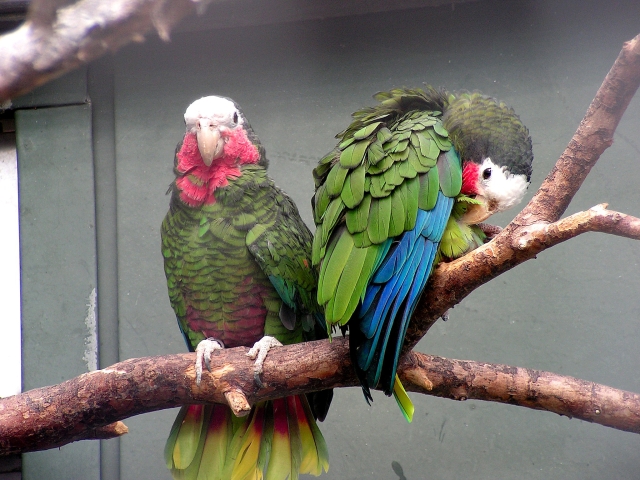
Cuban amazon, or Cubanparrot, or Rose-throated parrot(Amazona leucocephala)
Phylum —chordata
Class — aves
Order — psittaciformes
Family — psittacidae
Genus – amazona
Appearance
The Cuban amazon is a medium-sized parrot 28–33 centimeters (11–13 in) long. It is mainly green with some blue feathers in its wings. The green feathers are edged with a terminal black rim. Its lower face, chin and throat are rosy pink, and its forehead and eye-rings are white. The extent of the various colors of the head, the extent of the rosy pink on the upper chest, and the extent of the dull red on the abdomen vary between the subspecies. Its irises are pale olive-green, its beak is horn-colored, and the feathers over the ears are blackish. The legs are pink. The juvenile has little or no red on the abdomen, less black edging on the green feathers, and some of the feathers on the top of its head may be pale yellow rather than white.
Habitat
Cuban amazons are endemic to Cuba, the Bahamas and the Cayman Islands of the Caribbean. Mainly found at or close to sea level, they have been found in the Cuban mountains.
Behavior
Cuban amazons are diurnal and social. They relatively sedentary and do not migrate. Outside of the breeding season they are found in pairs, or groups with several birds, or 30 or more. They are generally very noisy especially while flying. Their calls are a range of shrill, metallic shrieks and harsh screeches. Although usually found in fairly big flocks, they may still maintain some manner of family unit, as within flocks, groups of twos or threes may be seen, the smaller groups leaving the flock to feed only with each other. The small group then joins the larger flock as night approaches. As with many parrot species that exhibit tactile communication by means of allopreening and beak grabbing play, it is likely that this species exhibits the same behavior.
Diet
Cuban amazons are herbivores (folivores and frugivores), they eat the seeds and fruits of a wide range of plants, such as cultivated fruit like mango and papaya, and also stems, blossoms and buds.
Reproduction
Cuban amazons are monogamous breeders and pairs mate for life. During the breeding season, they are seen more often on their own or in pairs, rather than in larger groups. Breeding is from March to September, with nests built in cavities in hollow trees, except for the population of Abaco Bahama amazons, which nest on the ground in limestone cavities. 2 to 4 white, almost round eggs are laid, and are incubated for a period of 26 to 28 days. The eggs hatch 12-72 hours apart and the chicks are altricial when born, without feathers and with their eyes closed. The chicks’ eyes open at about 3 weeks old and the nestling period is 56 to 60 days.
Cuban amazons can probably live up to 50 to 60 years.
In captivity
Keep the Cuban amazon in a spacious cage or an aviary. The ideal size of the cage is such that parrots can fly freely in it (1, 2x1, 2x2, 4 m). The cage must be locked with a strong and reliable lock so that the bird does not fly away. Inside the cage, you need to make several shelters in which the parrot will hide. It is desirable that the cage has an exit to the street, so that the amazon can spend time outdoors and take a sun bath.
Clean the amazon cage every day, and once a week you need to wash the contaminated areas of the cage, perches, toys. Also, you should replace the water in the drinking bowl with fresh water every day, and remove the remaining food from the cage. As parrots gnaw perches and branches they should be replaced.
Bathing parrots is vital for their plumage and skin. If the feathers are tarnished, it can be sprayed with fresh water from a spray bottle. After such a bath, leave the parrot to dry in a warm room or in the sun.
Amazons are fed granulated food with a high protein content. Fresh vegetables and fruits are added to the feed daily. When overfed, parrots become very picky about food. Because of their predisposition to obesity, amazons are given small amounts of sunflower or safflower seeds (only as a treat). If amazons are fed only seeds, they are additionally given vitamins and minerals to prevent the beriberi. It is preferable to add vitamins to soft foods rather than water, since such water serves as a good environment for the development of pathogenic bacteria.
The minimum size of the breeding house is 30x30x60 cm. Its bottom is covered with wood shavings for 10 — 20 cm. Sometimes some or all of the chicks have to be fed artificially. It is better to start artificial feeding when the chicks are 5-7 days old. During this period, parents will have time to provide their children with the necessary intestinal flora and enzymes that enter the stomachs of the chicks with food.
 Russian
Russian
 English
English























